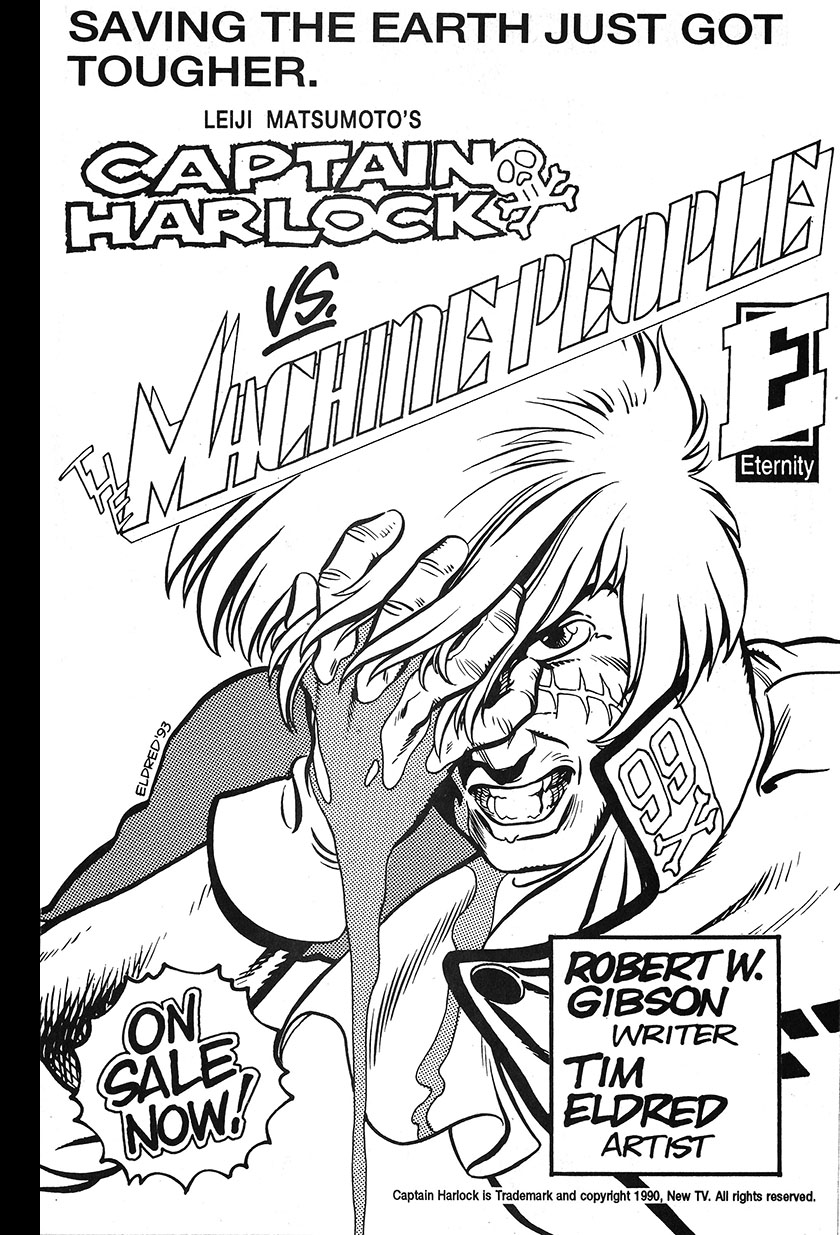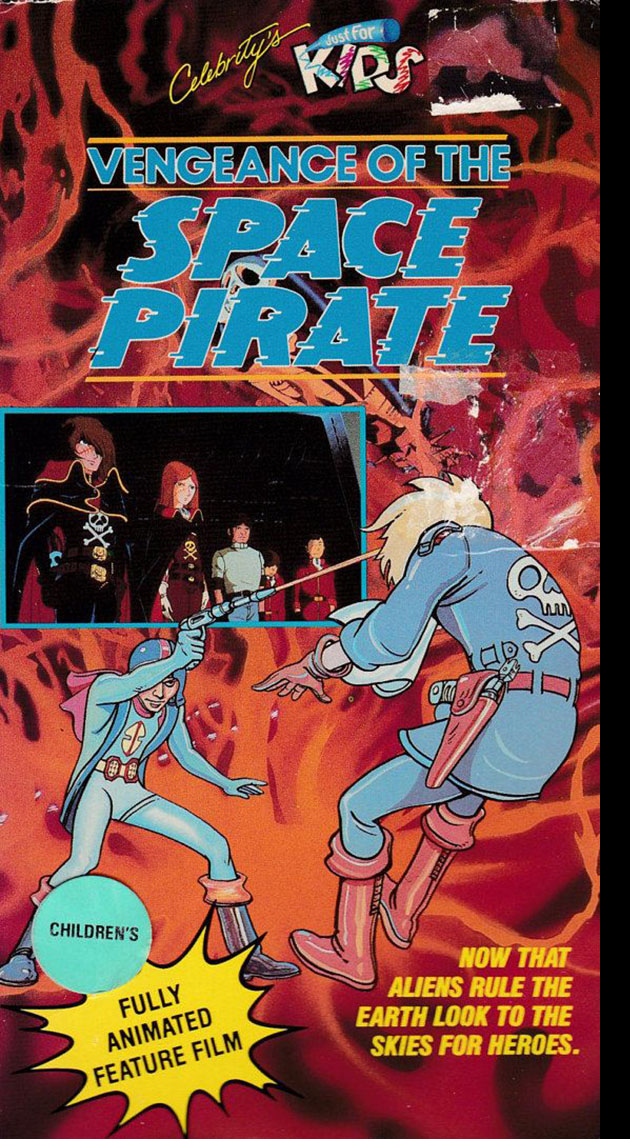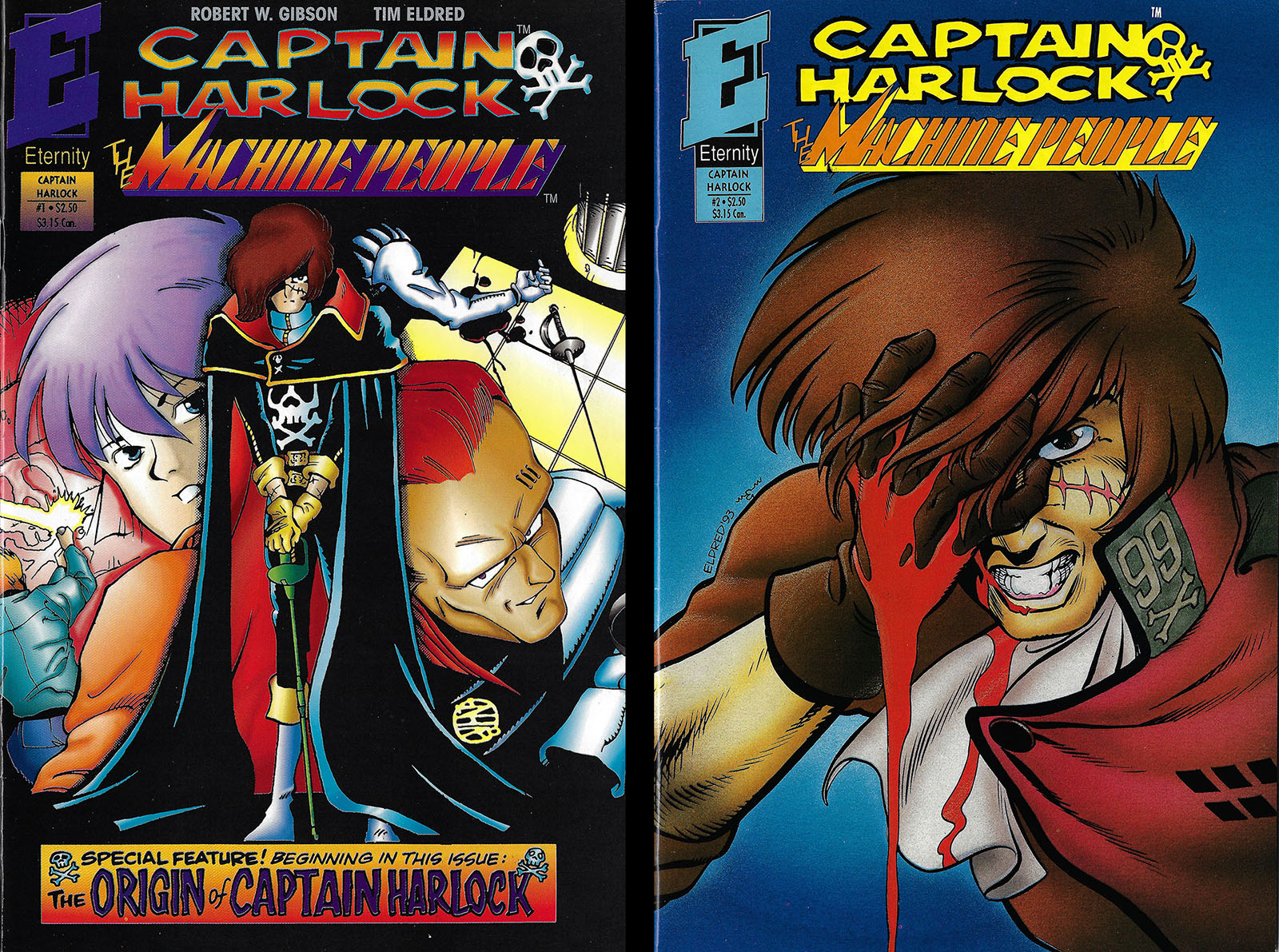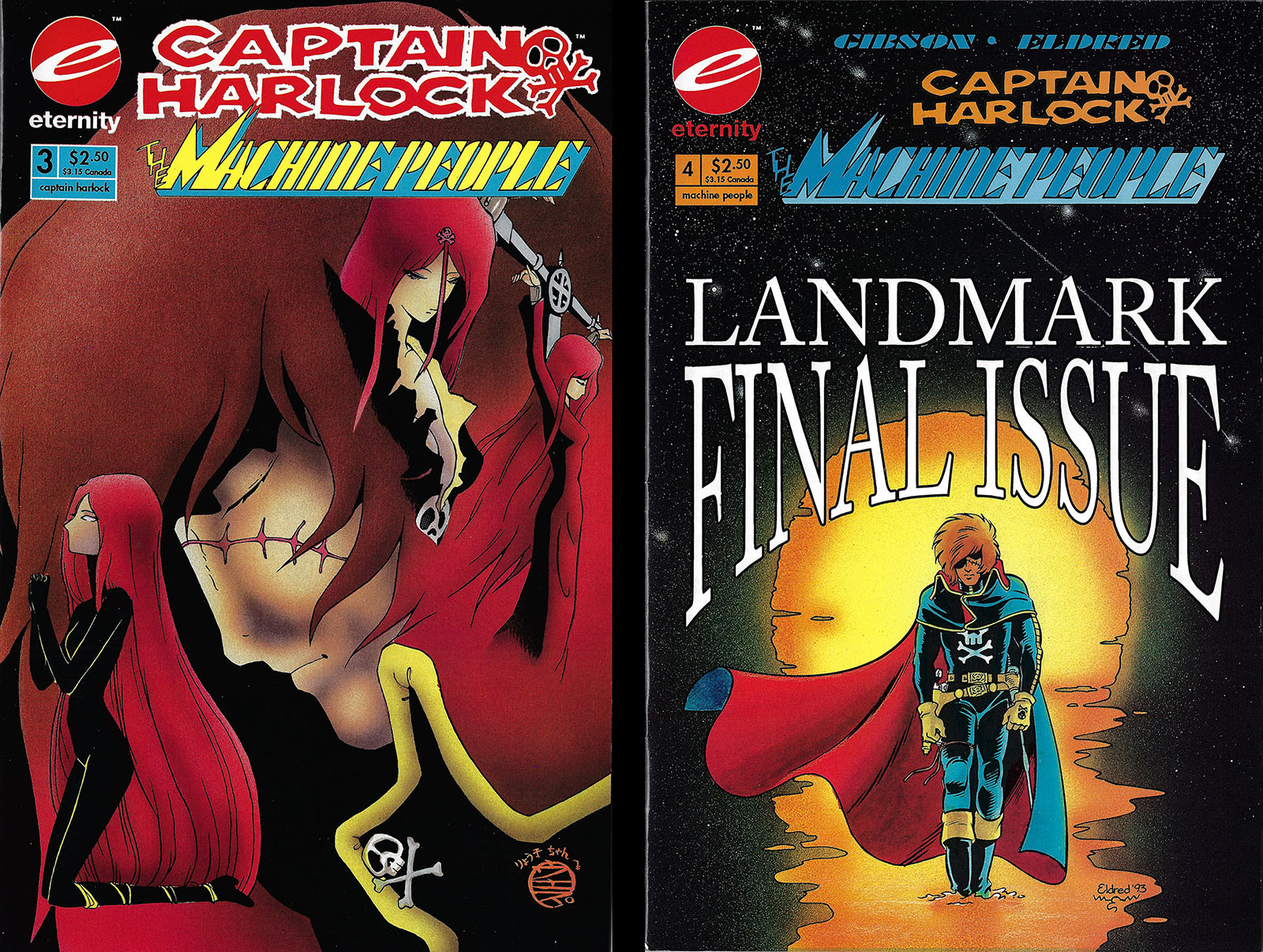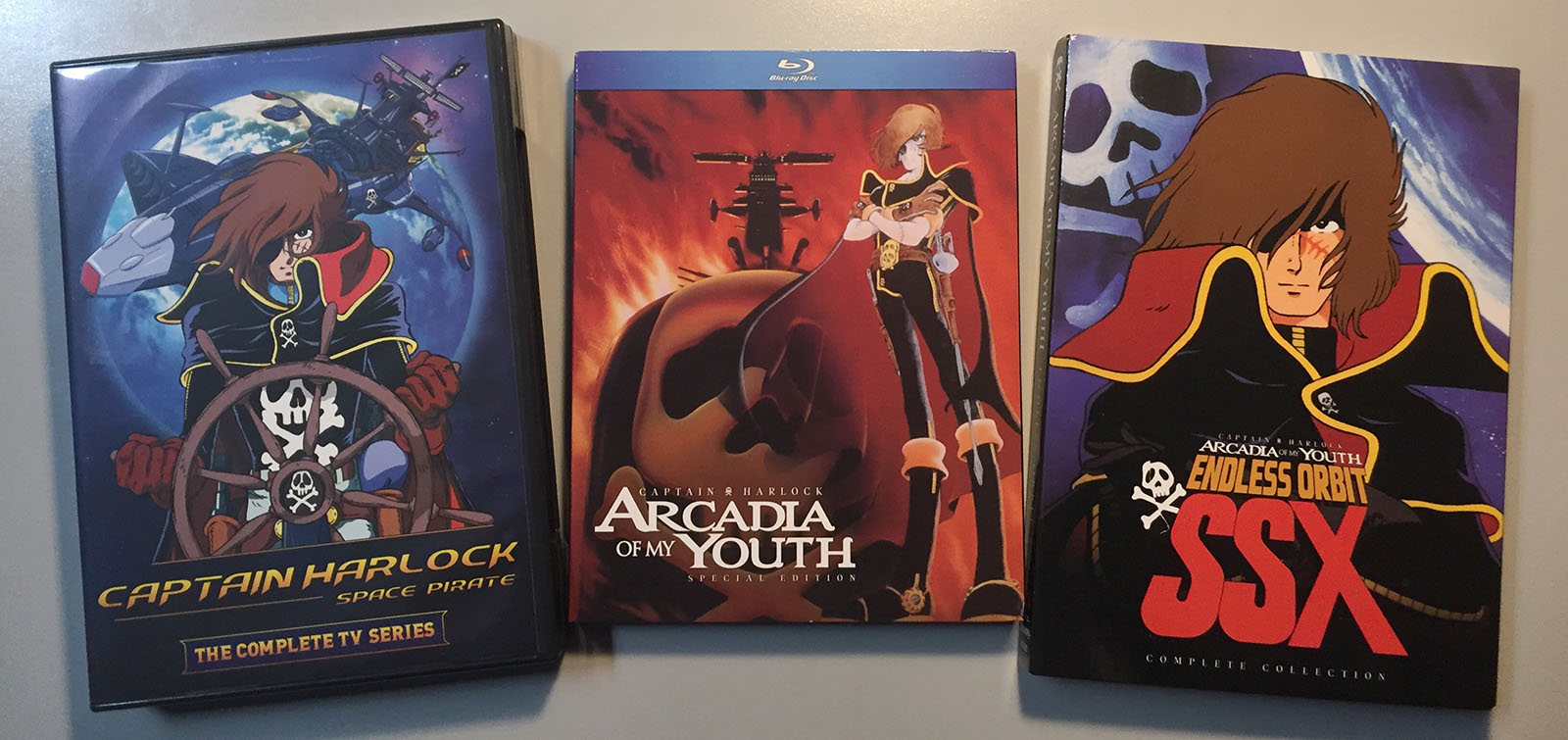Captain Harlock: The Machine People, 1993
When I started drawing this 4-issue miniseries, I didn’t know it would be the last hurrah. Robert Gibson didn’t, either, or he might not have used it to open a new story arc. In Fall of the Empire, we depicted the end of the Illumidas occupation of Earth, which was first established in the 1982 feature film My Youth in Arcadia. The Captain Harlock comics from Eternity picked up from that movie and created an alternate timeline to the Endless Road SSX TV series. (Some observers thought the Illumidas occupation was modeled after the US military occupation of Japan post WWII, but when I personally asked Leiji Matsumoto about this in 2010, he denied it. Read my interview with him here.)
Once the Illumidas were off the map, Robert wanted to set up a new villain called the Cabal Corporation; a group similar to Gundam‘s Zabi Family that propagated the technology for machine bodies we would later see in Galaxy Express 999. That’s where the title of this miniseries came from, and we were both prepared to take it as far as Eternity Comics would let us. Sales were still strong enough to support it.
The thing none of us saw coming was a licensing conflict that would slam the door on Robert’s plan just as it was beginning.
It’s thirty years later as I write these words, so there’s no reason not to tell the full tale as I learned it at the time. There are several players and it gets complicated, but it all comes back around, so get comfortable. First, the dinosaurs came. Then…wait, we can skip a bit…
First, there was a famous manga artist in Japan named Leiji Matsumoto who created a space pirate called Captain Harlock. The character evolved over several stories until his own series launched in 1977. An anime adaptation premiered on Japanese TV in 1978. When this series first came to America, it arrived with rudimentary subtitles via Hawaiian TV and made a few inroads to the mainland. But this was the pre-VHS world, so it didn’t get preserved.
Its next importer was Ziv International, a media company that had been around since 1971. They put out four episodes of Space Pirate on VHS in 1981. Two were dubbed for real and the other two were dubbed for comedy. Or at least that’s how it seemed to everyone at the time.
The third importer was Harmony Gold, which fused Space Pirate together (Robotech style) with the 1981 Queen Millennia TV series, an ill-advised approach that ground up both shows into an unwatchable paste. It debuted in 1985, then predictably crashed and burned.
As you can see from this track record, Captain Harlock was not set up for success. But it didn’t deter the fan base, which grew steadily throughout the 1980s thanks to underground VHS tape trading. Every anime fan who watched Star Blazers (Space Battleship Yamato) was primed to become a Harlock fan. My Youth in Arcadia was heavily traded and viewed thanks to an early subtitling effort. A heavily-edited and poorly mixed version was officially imported by Celebrity Home Entertainment in 1987 (shown at left). It was insultingly labeled “just for kids,” which made us all wonder if our favorite space pirate was ever going to be handled by someone who respected him.
When Malibu Comics (of which Eternity was an imprint) had their first wave of success with Robotech in 1988, they were curious to see what other anime titles they could pursue. They managed to get Lensman from Harmony Gold, which benefitted me a great deal. They also consulted with Ben Dunn (writer/artist of Ninja High School) who suggested they go after Captain Harlock. Malibu tracked the licensing to a Florida-based company called Coral Pictures, who had inherited the Harlock assets from Ziv International. Coral wasn’t doing anything with them, so when a comic book company phoned up and offered to license the publishing rights, Coral had no reason to decline.
I should state at this point that I’m relating the story to you as it was related to me by Malibu. Some facts may be fluid. But, on we go.
Eternity Comics published Captain Harlock #1 (written by Robert Gibson, drawn by Ben Dunn) in October 1989 and the wheels started turning for my tenure to begin about a year later. From the fall of 1990, I worked straight through on 13 issues until we were forced to take a year off. I managed to fill that year with other projects (Cybersuit Arkadyne, Invid War, Fathom, and Grease Monkey) before returning to the sea of stars. I was excited to be back, and wanted to push my art into new territory.
I had been developing my inking skills for a couple years by this time, and had reached a new level of confidence with my brushwork. That inspired me to go for a heavier touch; more definition and deeper shadows. I decided to go noir, framing entire pages with “full bleed black” (all the way to the edge of a page), which in turn motivated me to find more opportunities for light and shadow to tell the story. My character drawings were moving away from “Matsumoto style,” but he was well-known for heavy blacks in his manga, so it turned into a nice balancing act.
We were also bringing things full circle with a running adaptation (highly compressed) of My Youth in Arcadia, which represents an origin point for the main character. I adjusted the inking style slightly for those scenes to set them apart, but they worked equally well in the noir environment. I enjoyed the experiment and learned a lot from it. I was ready and willing to keep going.
But someone else was not: Toei Pictures. And they had veto power.
Toei, based in Japan, was the master licensor for Captain Harlock on behalf of Leiji Matsumoto. It took them a while to notice our comics, but apparently there was a moment when a Toei lawyer said “wait a minute…” and started doing some investigating. What they learned came as quite a surprise to Malibu. Coral Pictures was a fraud. They did not legally own the rights to Captain Harlock, and were not authorized to sublet them to anyone else. In other words, Space Pirate Captain Harlock had been…pirated.
Malibu itself was blameless. All they did was take Coral Pictures at their word. Their “deal” resulted in Malibu publishing the Ziv video, a script book that transcribed the Ziv video, and a successful comic book series that ran for 28 issues (of which I got to draw 17). When Toei declared that Malibu did not have clearance to keep going, they asked, “Can we finish our current series?” The answer was yes. “And then can we license it from you instead?” The answer was no. I don’t know if an explanation was ever given, but I can imagine that the idea of an American Harlock comic with no Japanese oversight did not interest them. Given the sketchy track record I recounted for you above, I can’t blame them.
Left to right: Walter Amos, me, Leiji Matsumoto, Gwyn Campbell, Anton Kholodov, Patrick Macias (December 2010)
When I finally got to meet and interview Leiji Matsumoto in 2010, I considered introducing myself as the artist of the American Harlock comic book, but decided against it. We had plenty else to talk about, and I had no idea how much awareness (or memory) he had of this incident. The last thing I wanted was to accidentally trip a landmine and knock the whole thing off the rails. So I let it pass without comment.
Anyway, the downshot of all that twisting and turning was that The Machine People brought Eternity’s Captain Harlock comics to a close. I’m glad I got my turn at the wheel, and I’m glad to have gone out on a high note. I’m really proud of how far my art evolved over the course of the series, and that the readers were happy to watch me get there. It proved an adage to me that has only become more true as the years go by: you get really good at something right before it ends.
SIDEBAR: 3-page teaser comic
Between drawing issues 1 and 2, my little family and I moved across the country (from Michigan to California) so I could take a staff job at Malibu Comics in Los Angeles. It was quite a heady time, adapting to a whole new lifestyle while also evolving my art style. Being in-house meant I could respond to editorial requests much faster. That’s what led to an impromptu 3-page mini comic that would promote The Machine People.
It appeared in two places at once: the first issue of a black & white Robotech series called Return to Macross and issue 25 of The Malibu Sun, a full color comic-size pamphlet that promoted all the titles for a given month. Malibu’s new color department needed things to do at the time, so this became the first (and only) Captain Harlock project published in color.
I wanted it to work equally well in both cases, so I drew it without tones and shading. This “A” version was scanned for the color department. Then I continued into a “B” version where I could add what was needed for black & white. The “C” version was in color. All three are presented below for comparison.
All the covers for The Machine People were drawn after the four issues were completed. I drew a cover for each, and another artist named Wes Abbot drew covers for 1-3. Editorial decided to use his covers for 1 and 3, and mine were used on the inside. The cover for issue 4 was based on the animated end titles from Endless Road SSX.
Postscript: to properly close all this out, here’s proof that Captain Harlock did eventually win the respect he was due.

